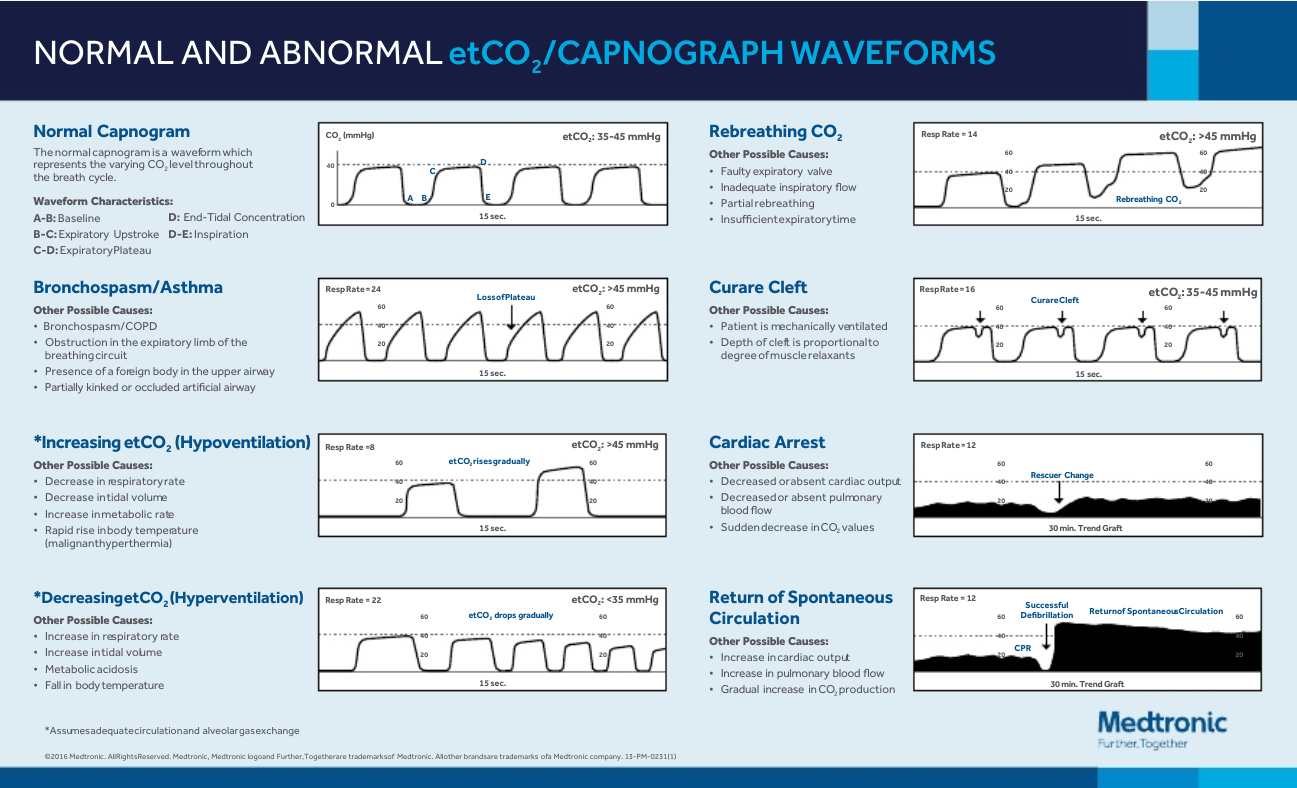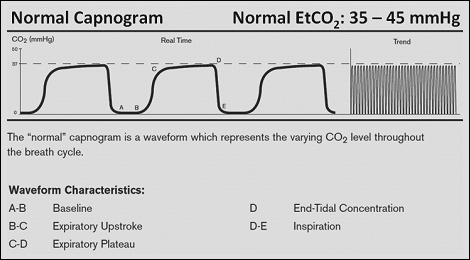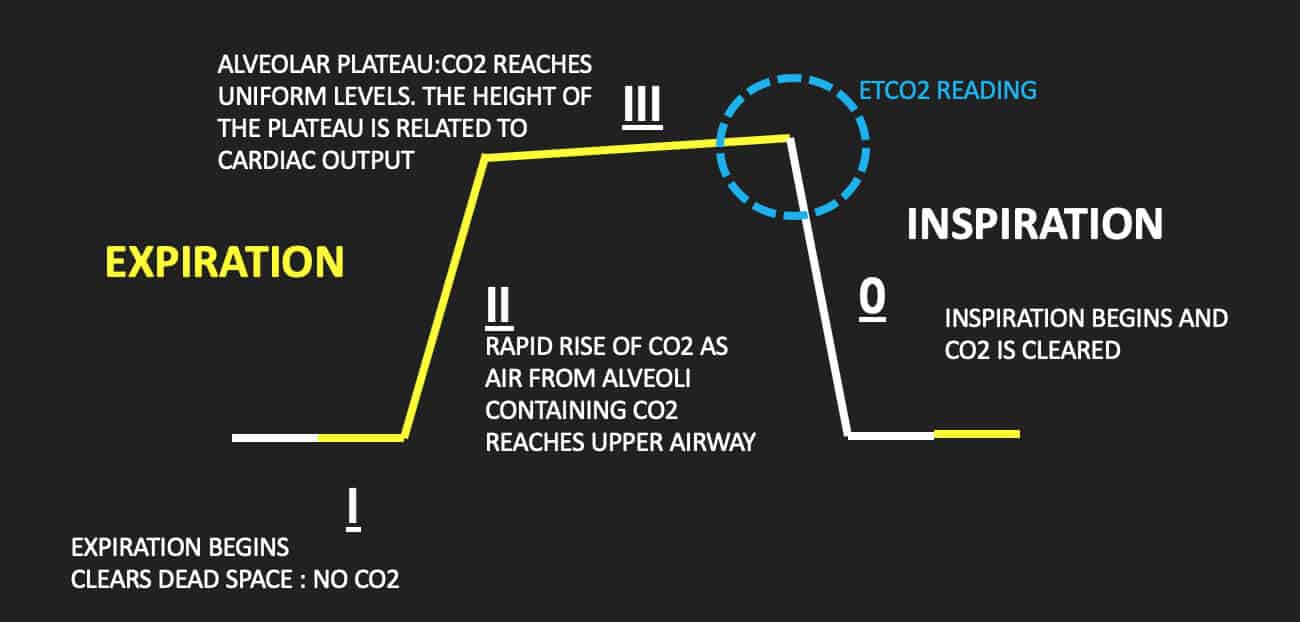normal end tidal co2 levels
In normal healthy lungs the match of arterial carbon dioxide and exhaled CO 2 is closely correlated. The end-tidal carbon dioxide was 67 mmHg at the time of the blood gas sampling.
Emdocs Net Emergency Medicine Educationcapnography In The Ed Emdocs Net Emergency Medicine Education
End-tidal carbon dioxide ETCO2 is the level of carbon dioxide that is released at the end of an exhaled breath.

. The waveform is called capnograph and shows how much CO 2 is present at each phase of the respiratory cycle. The level of CO 2 gradually rises during exhalation showing an approximate equalization with the CO 2 value in alveoli in the lungs hence the phrase end-tidal. When CO2 diffuses out of the lungs into the exhaled air a device called a.
Then larger or more frequent breaths may help to bring the CO2 levels back down to normal. End-tidal CO2 monitoring is a non-invasive way to monitor a patients carbon dioxide levels. The median ETCO 2 value was 32 mmHg IQR 27 38 mmHg range 18-80 mmHg.
Total pressure of a gas is the sum of the partial pressures of the gas Expired CO2 measured PetCO2 mmHg in waveform Percentage Normal Levels PaO2 85-100mmHg PaCO2 35-45mmHg Percentage vs. The height of the capnography waveform accompanies this number on the monitor as well as the. End tidal CO 2 monitoring is represented as a number and a graph on a monitor.
Circulating blood CO 2 is slightly greater than exhaled CO 2 due to a ventilation-perfusion VQ mismatch. Click to see full answer. Levels of end-tidal carbon dioxide are low despite normal respiratory rate in individuals with long COVID.
End-tidal capnography or end-tidal CO2 EtCO2 monitoring is a non-invasive technique that measures the partial pressure or maximal concentration of carbon dioxide CO2 at the end of an exhaled breath. End-tidal CO2 EtCO2 monitoring is a noninvasive technique which measures the partial pressure or maximal concentration of carbon dioxide CO2 at the end of an exhaled breath which is expressed as a percentage of CO2 or mmHg. Diagnosis of Increasing End-tidal Carbon Dioxide Carbon dioxide is produced in cells and after diffusing into the blood it is transported to the lung for excretion.
The amount of CO2 at the end of exhalation or end-tidal CO2 ETCO2 is normally 35-45 mm HG. MmHg Relate to the air we breath. The normal values are 5 to 6 CO2 which is equivalent to 35-45 mmHg.
Both end-tidal CO2 monitors and pulse oximetry devices work closely together to help monitor the respiratory status of a patient. 78 Nitrogen 21 Oxygen 1 CO2 and other gases Exhaled gases. So the short answer is you are right about the ranges 35-45 but that is for actual PaCo2 drawn from an ABG.
The creatine kinase was 1200 IUl and the partial thromboplastin time was normal. For a person with normal lungs the difference between end tidal and Paco2 can vary between 5-8mmHg depending on the book your reading. The number is called capnometry which is the partial pressure of CO 2 detected at the end of exhalation ranging between 35 - 45 mm Hg or 40 57 kPa.
End-tidal CO2 EtCO2 monitoring is a noninvasive technique which measures the partial pressure or maximal concentration of carbon dioxide CO2 at the end of an exhaled breath which is expressed as a percentage of CO2 or mmHg. End-tidal CO2 EtCO2 monitoring is a noninvasive technique which measures the partial pressure or maximal concentration of carbon dioxide CO2 at the end of an exhaled breath which is expressed as a percentage of CO2 or mmHg. In patients with normal pulmonary function CO 2 normally 35 to 45 mm Hg and ETco 2 should correlate closely with a deviation of about 2 to 5 mm Hg.
If a patient has low CO2. The normal values are 5 to 6 CO2 which is equivalent to 35-45 mmHg. The normal values are 5 to 6 CO2 which is equivalent to 35-45 mmHg.
On average during CPR if adequate chest compressions are being delivered a cardiac index of 16-19 Lminm2 can be generated which correlates with ETCO2 pressures of 20mmHg. ETCO2 levels reflect the adequacy with which carbon dioxide CO2 is carried in the blood back to the lungs and exhaled. Levels of end-tidal carbon dioxide are low despite normal respiratory rate in individuals with long COVID J Breath Res.
The normal values are 5-6 CO2 which is equivalent to 35-45 mmHg. Ganong 1995 or partial pressure of 53 of normal air at sea level. 1-3 Clinicians may however observe a widened or increased gradient.
Available evidence has established that ETCO2 measurement can provide an indication of cardiac output and pulmonary blood flow24 Non. In the awake adult normal cardiac index lies between 25-4 Lminm2 with an ETCO2 of 35-45 mmHg. In thromboembolism ETCO2 is significantly lower than normal due to the reduction of pulmonary perfusion and increased alveolar dead space that reduces the amount of CO2 exhaled from the lungs so venous carbon dioxide pressure PvCO2 increases and all of these changes lead to an increase in arterial CO2-ETCO2 gradient.
The normal alveolar CO 2 pressure is about 40 mm Hg pressure Guyton 1984. 2 to near normal normal EtCO 2 35-45 mmHg represents marked increase of CO 2 delivery to lungs suggesting ROSC If patient develops an organized rhythm after VFVTasystole check EtCO 2 to see if ROSC has occurred CONFIRM PLACEMENT OF ETT After intubation if ETCO 2 10mm Hg tube in trachea. With a normal match of alveolar ventilation and perfusion this gradient is roughly 2 to 5 mmHg where the arterial carbon dioxide is greater than the exhaled carbon dioxide.
Forty-six of 96 48 95 confidence interval CI 38 58 patients had abnormal ETCO 2 values including 37 39 95 CI 29 49 with low ETCO 2 levels and. 11172009 4 Measuring End Tidal CO2 Daltons Law.

Exhaled Carbon Monoxide End Tidal Co2 And Peripheral Oxygen Saturation Download Table

Basic Capnography Interpretation Nuem Blog
The Normal Capnograph Waveform Deranged Physiology
5 Medical Conditions Where Capnography Can Affect Bls Care Capnoacademy Capnoacademy

Waveform Capnography In The Intubated Patient Emcrit Project

End Tidal Capnography Can Be Useful For Detecting Diabetic Ketoacidosis Monitoring Copd Acep Now

Exhaled Carbon Monoxide End Tidal Co2 And Peripheral Oxygen Saturation Download Table
Riding The Wave Of Capnography Understanding Etco2 Vetbloom Blog

Pdf Applications Of End Tidal Carbon Dioxide Etco2 Monitoring In Emergency Department A Narrative Review Semantic Scholar

Average Etco2 Kpa During Cpr In Patients With Or Without Rosc Download Scientific Diagram

Waveform Capnography In The Intubated Patient Emcrit Project

Waveform Capnography In The Intubated Patient Emcrit Project
End Tidal Co2 Monitoring In The Pre Hospital Environment More Than Just Endotracheal Tube Placement Confirmation Journal Of Paramedic Practice

Normal And Abnormal Capnography Waveforms Infographic Capnoacademy Capnoacademy

Capnography Provides Bigger Physiological Picture To Maximize Patient Care Jems Ems Emergency Medical Services Training Paramedic Emt News

Capnogram R Series Defibrillator Zoll Medical Uk

The Impact Of Ventilation Rate On End Tidal Carbon Dioxide Level During Manual Cardiopulmonary Resuscitation Resuscitation

